Last month, John Murphy of FPF Training invited me to Dallas to take his ‘Street Encounters Skills and Tactics” course. I’ve been friends with John for a long while and he has been hosting me at his Virginia facility for about seven years. I have taken several of his classes at conferences like Rangemaster Tac Con, but I had never taken his flagship two-day course. I wanted to remedy that.
The description of the course on John’s website is as follows:
Concealed Carry: Street Encounter Skills and Tactics prepares citizens for personal security challenges by equipping them with a comprehensive suite of “soft” and “hard” skills that are woven into a holistic approach to legal self-defense.
Who is this course for?
This course is for the person who recognizes that there is much more to personal safety than simply carrying a gun. If you want to expand your knowledge and acquire skills oriented toward the layered nature of civilian self-defense, this class is for you.
Methodology
Employing an iterative approach, students progressively acquire skills and knowledge required to enforce their security decisions and secure themselves before, during and after an incident. Among these skills are:
Stopping Bleeding (Medical Trauma)
Employing Pepper Spray (Less-Lethal Options)
Interacting with Law Enforcement (Legal Preparation)
Street Encounter Skills (Managing contacts and conflicts for de-escalation and de-selection)
Subsequently these concepts and newly acquired skills are reinforced and validated as students are exposed to a combination of drills and scenario-based exercises emphasizing decision-making and decisively employing an appropriate course of action.
End state
Students will be equipped with an understanding of the threats they face and provided a comprehensive suite of skills and tactics that enable them to respond to these circumstances within legal and moral constraints.
*Please note that the live-fire portions of this course are primarily concerned with the decisions and consequences involved with the application of deadly force. Various techniques are discussed and demonstrated, but the emphasis is “when and where” to apply deadly force rather than shooting skills.
So the class covers tactical first aid, pepper spray use, verbal interaction with criminals, dealing with police post shooting, and shooting in a street environment. I teach all those skills myself and have instructor certifications in most of the subject areas. Why would I want to go to a course like that?
The answer is that I think John has put together the single best two day class for the shooter who has completed a gun safety/CCW class and is looking for more training. His curriculum and teaching style provide the new-ish shooter exactly the skills they need to win a street encounter without any fluff or fanfare.
I was excited to see that my friend and industry luminary Wayne Dobbs would be taking the class with me as a student. Wayne is also an experienced retired cop who makes a living as a professional instructor. When two of the eight students in the class already instruct the material you are teaching, yet still come to class, that’s a clue that you are delivering a quality product.
John exceeded all expectations.
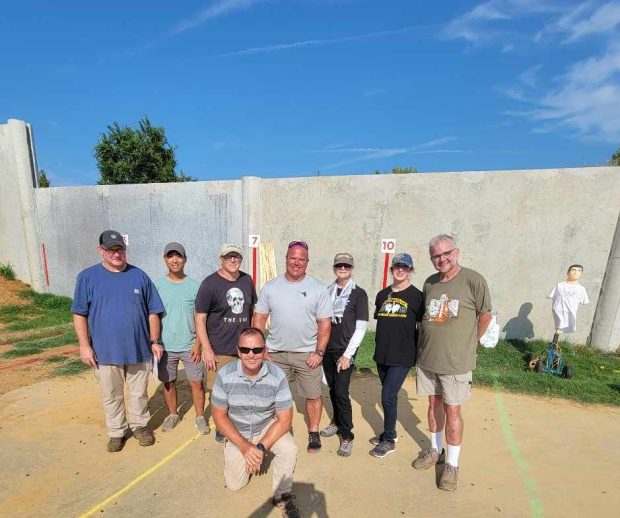
Class photo
Day one contained no live fire. We worked simulated draws with neutered training guns, but we primarily focused on issues of “managing unknown contacts” with strangers along with pepper spray carry, access, and use. John provided the students with both inert POM training units and a canister of live POM OC. During practice, we sprayed targets both days and did several simulated scenarios where john acted as the aggressor and we sprayed him.
We also covered the basics of tactical first aid for gunshot wounds, covering basic tourniquet and pressure bandage use. John provided each student with an ankle medical kit containing a tourniquet and pressure bandage to use in class. Once he taught the basics, we would randomly be instructed to provide first aid on simulated injuries while completing drills both days.
It was a good way to teach the skills and practice them in a realistic context.
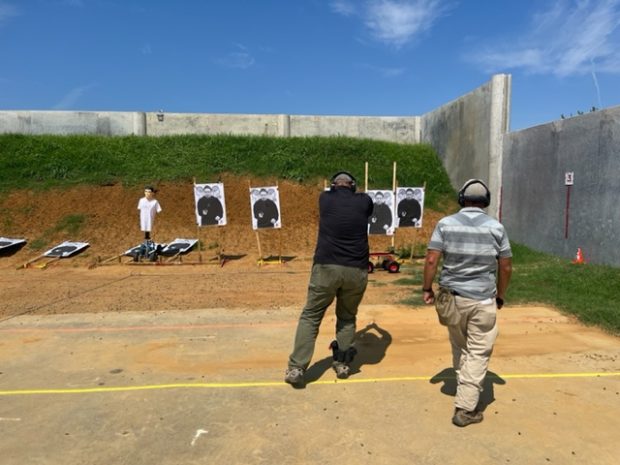
Wayne Dobbs moving quickly to get a better angle on the moving target (note ankle medical kit on his leg).
We did some dry fire work with our pistols, covered what to say when calling police and did some work from several different “ready positions” for our pistols.
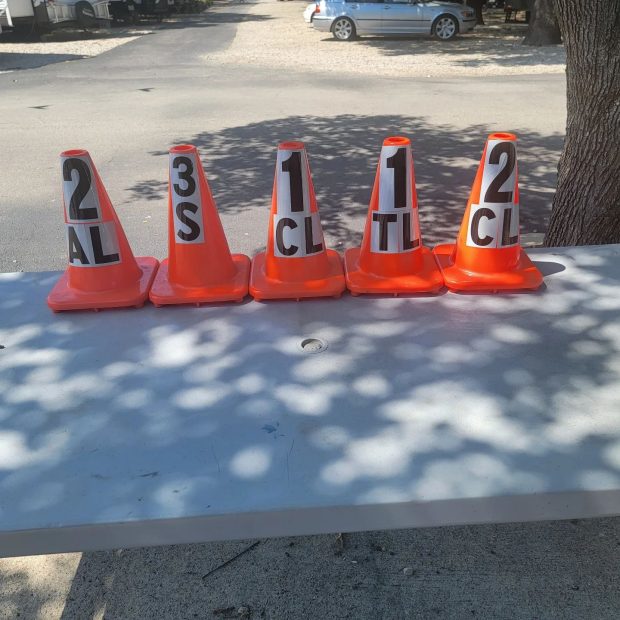
Distance markers for the range that reflect useful measurements rather than simply numbers. This is intended to help students understand the relationship between time, distance and speed.
2 arm lengths
3 steps
1 car length
1 truck length
2 car lengths
On Sunday we began shooting working by both slow fire accuracy and fast single shots from the holster.
John then introduced lateral movement, verbalization and post-incident actions.
We timed our responses to lethal threats represented by visual rather than auditory cues. That isn’t done in most classes and is a serious weakness. Your “go signal” in a real gunfight won’t likely be the beeping sound of a shot timer. We then moved and shot based upon cues from our peripheral vision. Later exercises had us shooting moving and charging targets, another unique training experience for most.
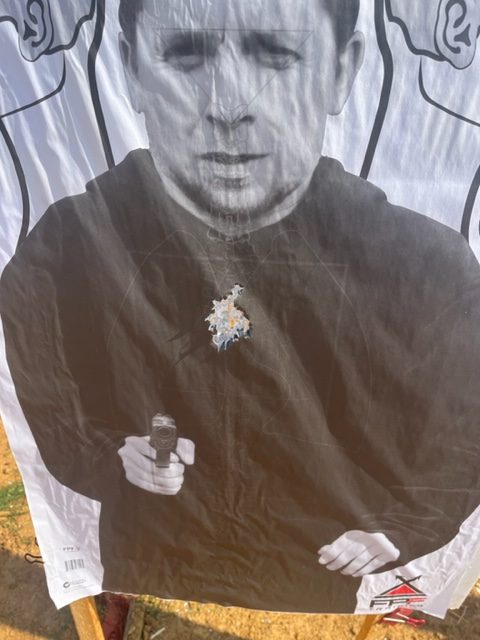
I did OK on the first few shooting drills
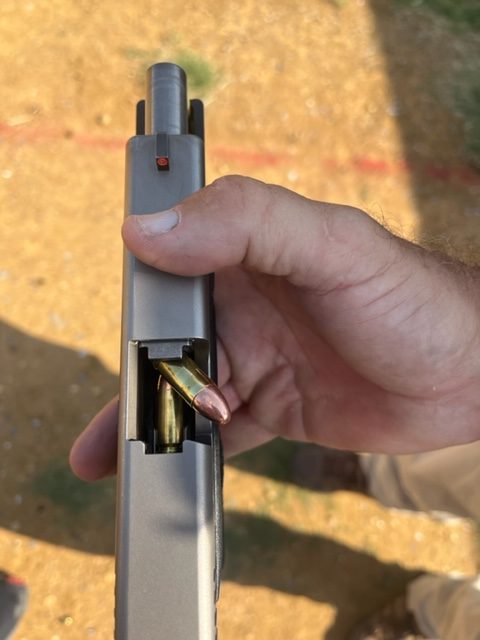
An unusual student malfunction
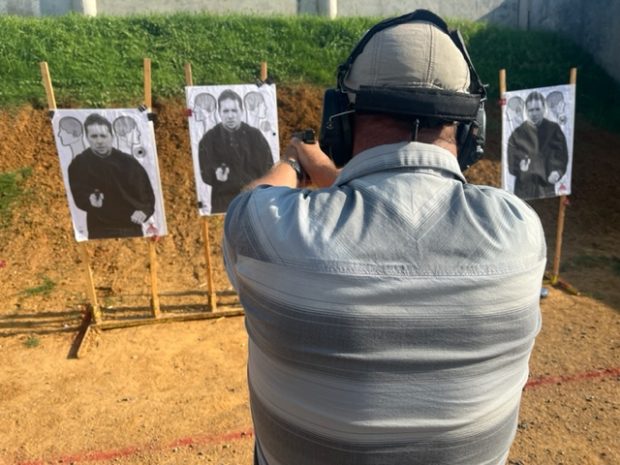
Murph demonstrating one of his shooting drills
One of the most unique aspects of the training class was John’s use of moving targets and backstops filled with “no shoot” targets. We did a lot of work with complicated downrange problems, muzzle aversion issues, moving targets shot while the students were moving as well, and partner signaled visual threat cues. For a look at one of the moving target drills, watch the video below.
Moving Target Drill
Throughout our shooting drills, John continually and randomly made us verbalize against our target, deploy pepper spray, and provide medical care as required. We also practiced calling the police and giving them the pertinent information they need to respond.
I fired exactly 222 rounds of OMUSHA 9mm ammunition through my Glock 19 carried in a PHL-ster Enigma holster over the weekend. All products worked exceedingly well with no malfunctions from any item.
John has created the single best “second step” training for newer gun owners. Even very experienced shooters would benefit from this training class. Take a look at John’s schedule for next year and get in to this class!
For more info about Mr. Murphy, please check out the “Trainers You Should Know” article I wrote about his work.

FPF Training 2023 schedule
FTC Disclosure: FPF Training provided this class to me free of charge. I paid all travel, accommodation, and ammunition costs myself. John provided me a slot in the class without any expectation of any review or endorsement. It’s a good class and you should take it. I’m not being paid to say that.

